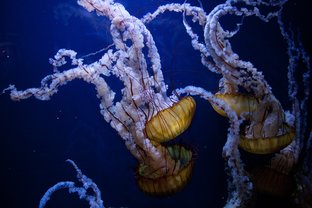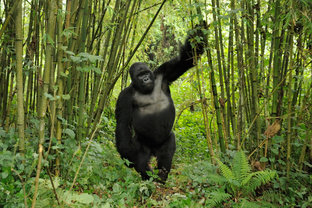As climate change impacts habitats around the world, species are on the move, trying to adapt — and survive.
Featured Species
American Lobster
Maine's lobster industry is booming, for now. The same climate shifts that drove the delicacy into Maine could push it into Canada in the coming decades.
African Elephant

As the climate heats up, African Elephants' long generation time and need for fresh water puts them at risk.
American Lobster

Maine's lobster industry is booming, for now. The same climate shifts that drove the delicacy into Maine could soon push it into Canada.
Asian Elephant

Asian elephants once roamed across much of Asia. Already their habitat has shrunk, and it's about to get worse.
Bald Eagle

Bald Eagles have survived DDT and a public shaming by Benjamin Franklin. But climate change? That could be trouble.
Bats of the Brazilian Cerrado

By 2050, the bats of the Brazilian Cerrado will have to move 175 miles to find a suitable home. But can they?
Blacklegged Tick

Warmer temperatures and shorter winters mean more blacklegged ticks and more Lyme disease. Ticks love climate change.
Burrowing Owl

Like the name suggests, the Burrowing Owl likes to burrow. Its range is rapidly changing—will the owl change too?
Caspian Tern

Researchers recently found Caspian terns 1,000 miles north of where they're expected to be. Major moves are just beginning.
Common Loon

This icon of the North could lose much of its breeding range as a result of climate change.
Eastern Whip-poor-will

Whip! Poor! Will! The distinctive cries of the eastern whip-poor-will are already gone in some areas.
Greater Sage-Grouse

The Greater Sage-Grouse, which relies on its habitat in the western desert, could be in serious trouble.
Jellyfish

Jellyfish are the rare species that like climate change. That's bad news for the rest of us.
Lemur

With climate change, the already vulnerable lemurs of Madagascar will see their ranges shrink—or disappear.
Monarch Butterfly

Monarch butterflies can migrate 3,000 miles, but they can't escape climate change.
Mountain Gorilla

The habitat of the critically endangered mountain gorilla is already small. Climate change is shrinking it further.
Osprey

The Osprey bounced back after pesticides left it seriously endangered. Can the species also survive climate change?
Phytoplankton

The ocean's tiniest organisms are experiencing major changes—with the potential for major consequences.
Seaweed

On land we have trees. In the ocean, there is seaweed. And these diverse, crucial species are in trouble.
Snow Leopard

Climate change is pushing humans into snow leopard territory, threatening the already-endangered species.
Threadfin Butterflyfish

The tropical Threadfin Butterflyfish might be finding a new home as temperatures off the southeast coast of Australia become more welcoming.
Tundra Swan

The Tundra Swan makes its summer home in the North American Arctic, where climate change is disproportionately felt.
Yellow-Billed Magpie

Within 65 years, climate change could claim 80 percent of the Yellow-Billed Magpie's summer range—and all of its winter range.



